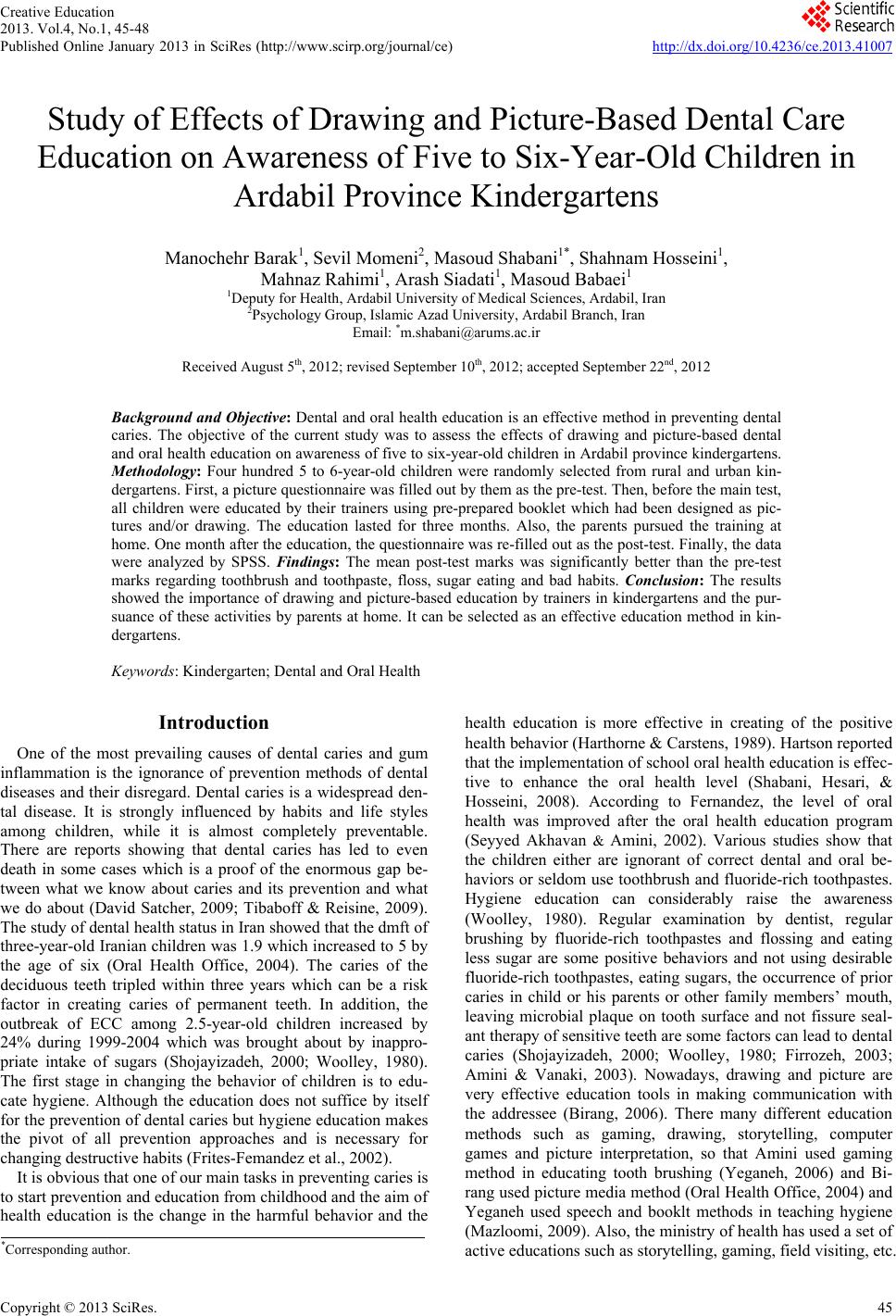
Creative Education
2013. Vol.4, No.1, 45-48
Published Online January 2013 in SciRes (http://www.scirp.org/journal/ce) http://dx.doi.org/10.4236/ce.2013.41007
Copyright © 2013 SciRes. 45
Study of Effects of Drawing and Picture-Based Dental Care
Education on Awareness of Five to Six-Year-Old Children in
Ardabil Province Kindergartens
Manochehr Barak1, Sevil Momeni2, Masoud Shabani1*, Shahnam Hosseini1,
Mahnaz Rahimi1, Arash Siad ati1, Masoud Babaei1
1Deputy for Health, Ardabil University of Medical Sciences, Ardabil, Iran
2Psychology Group, Islamic Azad University, Ardabil Branch, Iran
Email: *m.shabani@arums.ac.ir
Received August 5th, 2012 ; revised September 10th, 2012; accepted September 22nd, 2012
Background and Objective: Dental and oral health education is an effective method in preventing dental
caries. The objective of the current study was to assess the effects of drawing and picture-based dental
and oral health education on awareness of five to six-year-old children in Ardabil province kindergartens.
Methodology: Four hundred 5 to 6-year-old children were randomly selected from rural and urban kin-
dergartens. First, a picture questionnaire was filled out by them as the pre-test. Then, before the main test,
all children were educated by their trainers using pre-prepared booklet which had been designed as pic-
tures and/or drawing. The education lasted for three months. Also, the parents pursued the training at
home. One month after the education, the questionnaire was re-filled out as the post-test. Finally, the data
were analyzed by SPSS. Findings: The mean post-test marks was significantly better than the pre-test
marks regarding toothbrush and toothpaste, floss, sugar eating and bad habits. Conclusion: The results
showed the importance of drawing and picture-based education by trainers in kindergartens and the pur-
suance of these activities by parents at home. It can be selected as an effective education method in kin-
dergartens.
Keywords: Kindergarten; Dental and Oral Health
Introduction
One of the most prevailing causes of dental caries and gum
inflammation is the ignorance of prevention methods of dental
diseases and their disregard. Dental caries is a widespread den-
tal disease. It is strongly influenced by habits and life styles
among children, while it is almost completely preventable.
There are reports showing that dental caries has led to even
death in some cases which is a proof of the enormous gap be-
tween what we know about caries and its prevention and what
we do about (David Satcher, 2009; Tibaboff & Reisine, 2009).
The study of dental health status in Iran showed that the dmft of
three-year-old Iranian children was 1.9 which increased to 5 by
the age of six (Oral Health Office, 2004). The caries of the
deciduous teeth tripled within three years which can be a risk
factor in creating caries of permanent teeth. In addition, the
outbreak of ECC among 2.5-year-old children increased by
24% during 1999-2004 which was brought about by inappro-
priate intake of sugars (Shojayizadeh, 2000; Woolley, 1980).
The first stage in changing the behavior of children is to edu-
cate hygiene. Although the education does not suffice by itself
for the prevention of dental caries but hygiene education makes
the pivot of all prevention approaches and is necessary for
changing destructive habits (Frites-Femandez et al., 2002).
It is obvious that one of our main tasks in preventing caries is
to start prevention and education from childhood and the aim of
health education is the change in the harmful behavior and the
health education is more effective in creating of the positive
health behavior (Harthorne & Carstens, 1989). Hartson reported
that the implementation of school oral health education is effec-
tive to enhance the oral health level (Shabani, Hesari, &
Hosseini, 2008). According to Fernandez, the level of oral
health was improved after the oral health education program
(Seyyed Akhavan & Amini, 2002). Various studies show that
the children either are ignorant of correct dental and oral be-
haviors or seldom use toothbrush and fluoride-rich toothpastes.
Hygiene education can considerably raise the awareness
(Woolley, 1980). Regular examination by dentist, regular
brushing by fluoride-rich toothpastes and flossing and eating
less sugar are some positive behaviors and not using desirable
fluoride-rich toothpastes, eating sugars, the occurrence of prior
caries in child or his parents or other family members’ mouth,
leaving microbial plaque on tooth surface and not fissure seal-
ant therapy of sensitive teeth are some factors can lead to dental
caries (Shojayizadeh, 2000; Woolley, 1980; Firrozeh, 2003;
Amini & Vanaki, 2003). Nowadays, drawing and picture are
very effective education tools in making communication with
the addressee (Birang, 2006). There many different education
methods such as gaming, drawing, storytelling, computer
games and picture interpretation, so that Amini used gaming
method in educating tooth brushing (Yeganeh, 2006) and Bi-
rang used picture media method (Oral Health Office, 2004) and
Yeganeh used speech and booklt methods in teaching hygiene
(Mazloomi, 2009). Also, the ministry of health has used a set of
active educations such as storytelling, gaming, field visiting, etc.
*Corresponding author.